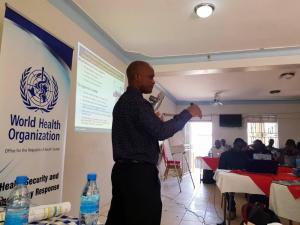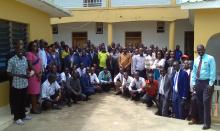South Sudan, Uganda, and Kenya strengthen implementation of cross-border disease surveillance and outbreak response in East Africa
Juba 27 April, 2018: The Republic of South Sudan hosted a joint cross-border multi-sectoral disease surveillance meeting in Nimule, South Sudan from 24-26 April, 2018. Experts drawn from human, animal, environmental health and immigration sectors of South Sudan, Uganda, and Kenya deliberated on mechanisms to strengthen implementation of cross boarder disease surveillance and outbreak response in the region.
The meeting was convened by the World Health Organization (WHO), the East African Community, the East Central and Southern Africa - Health Community (ECSA-HC) through the East Africa Public Laboratory Networking project and the respective Ministries of Health in South Sudan, Uganda, and Kenya.
The meeting assessed current surveillance strategies, identified challenges and formulated plans to improve preparedness and response across the region in line with the International Health Regulations (2005).
The East African region has been threatened by numerous emerging and re-emerging disease outbreaks of international concern with potential to spread across borders including polio, yellow fever, Ebola Virus disease, Marburg Viral fever, Crimean Congo hemorrhagic fever, Hepatitis E virus, cholera, measles, meningitis, rift valley fever, and strange outbreaks of unknown origin.
‘The risk of disease outbreaks is enhanced by the increased cross-border trade, movements of humans, animals and goods for trade, high population crowdedness, effects of climate change, and proximity to the Congo basin hotspot and the characteristics of rift valley environment’ said Dr Joseph Wamala, Epidemiologist at WHO South Sudan on behalf of Mr Evans Liyosi, WHO Representative a.i. to South Sudan. He implored surveillance officers to strengthen joint cross-border disease surveillance and response, and reiterated WHO’s commitment to provide the requisite technical support.
Although all partner states of the East African Community (EAC) – Burundi, Kenya, Rwanda, South Sudan, Tanzania and Uganda, are implementing the WHO Integrated Disease Surveillance and Response (IDSR) strategy to contain epidemic prone diseases, there is need to strengthen disease surveillance and outbreak response core capacities for enhanced regional public health security. The EAC partner states are implementing the East Africa Public health laboratory networking project (EAPHLNP) supported by the World Bank. The main purpose of the EAPHLNP is to establish a network of efficient, high quality, accessible public health laboratories for the diagnosis and surveillance of IDSR priority diseases including Tuberculosis (TB) and other communicable diseases, with emphasis to cross-border areas. Through this project, borders of East Africa were demarcated into eight surveillance zones with multi-sectoral teams to oversee cross-border disease control activities.
During the Nimule cross-border meeting, an additional surveillance zone (zone 9) was established as a tripartite zone covering South Sudan, Kenya, and Uganda. For operational effectiveness, zone 9 was further divided into three sub-zones that were mandated to form cross-border health committees, conduct joint IDSR/IHR (2005) trainings, share surveillance data, and conduct joint outbreak investigations and synchronized response to regional public health threats.
The meeting noted that although progress has been registered in the three countries, South Sudan, which joined the East African Community later, still has a lot of gaps especially regarding laboratory capacities, cross border surveillance, and implementation of other IHR (2005) core capacity requirements. To address these gaps, the South Sudan team with support from WHO has developed a concept note to join the EAPHLNP and solicit for support to strengthen surveillance, laboratory, and other IHR (2005) capacities at all levels.
The EAC secretariat in collaboration with the ECSA-HC will revise the EAC cross-border surveillance framework to ensure South Sudan is adequately covered including assigning officers to the regional rapid response team. The follow-up cross-border activities will include regular cross-border simulation exercises, joint outbreak investigations, and synchronized response interventions in the event of cross border disease outbreaks as well as evaluation of cross border surveillance committees. It is envisaged that investments in a stronger preparedness, diseases surveillance and response system across the three countries will yield better outcomes and save lives.





